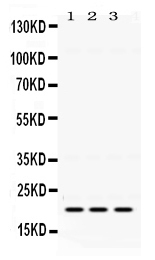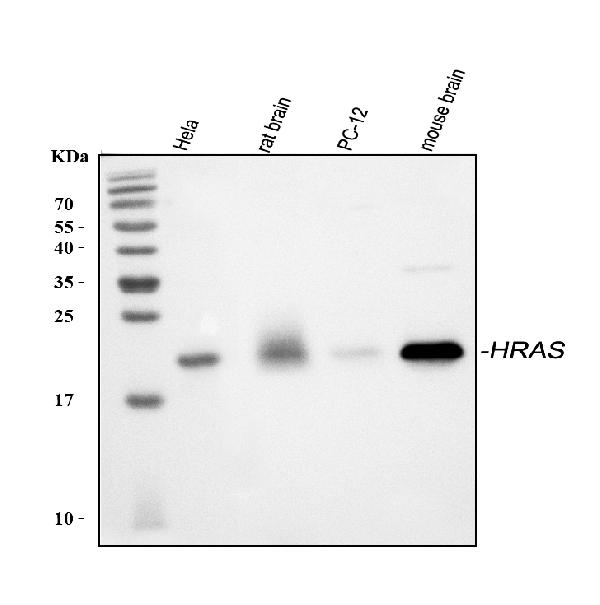Product Info Summary
| SKU: | RP1098 |
|---|---|
| Size: | 100 μg/vial |
| Reactive Species: | Human, Mouse |
| Host: | Rabbit |
| Application: | WB |
Customers Who Bought This Also Bought
Product info
Product Name
Anti-GTPase HRAS Antibody Picoband®
SKU/Catalog Number
RP1098
Size
100 μg/vial
Form
Lyophilized
Description
Boster Bio Anti-GTPase HRAS Antibody catalog # RP1098. Tested in WB applications. This antibody reacts with Human, Mouse. The brand Picoband indicates this is a premium antibody that guarantees superior quality, high affinity, and strong signals with minimal background in Western blot applications. Only our best-performing antibodies are designated as Picoband, ensuring unmatched performance.
Storage & Handling
Store at -20˚C for one year from date of receipt. After reconstitution, at 4˚C for one month. It can also be aliquotted and stored frozen at -20˚C for six months. Avoid repeated freeze-thaw cycles.
Cite This Product
Anti-GTPase HRAS Antibody Picoband® (Boster Biological Technology, Pleasanton CA, USA, Catalog # RP1098)
Host
Rabbit
Contents
Each vial contains 5mg BSA, 0.9mg NaCl, 0.2mg Na2HPO4, 0.05mg NaN3.
Clonality
Polyclonal
Isotype
Rabbit IgG
Immunogen
A synthetic peptide corresponding to a sequence at the C-terminus of human GTPase HRAS, identical to the related mouse and rat sequences.
*Blocking peptide can be purchased. Costs vary based on immunogen length. Contact us for pricing.
Cross-reactivity
No cross-reactivity with other proteins
Reactive Species
RP1098 is reactive to HRAS in Human, Mouse
Reconstitution
Add 0.2ml of distilled water will yield a concentration of 500ug/ml.
Observed Molecular Weight
21 kDa
Calculated molecular weight
21298 MW
Background of HRAS
GTPase HRas, also known as transforming protein p21, is an enzyme that in humans is encoded by the HRAS gene. This gene belongs to the Ras oncogene family, whose members are related to the transforming genes of mammalian sarcoma retroviruses. The products encoded by these genes function in signal transduction pathways. These proteins can bind GTP and GDP, and they have intrinsic GTPase activity. This protein undergoes a continuous cycle of de- and re-palmitoylation, which regulates its rapid exchange between the plasma membrane and the Golgi apparatus. Mutations in this gene cause Costello syndrome, a disease characterized by increased growth at the prenatal stage, growth deficiency at the postnatal stage, predisposition to tumor formation, mental retardation, skin and musculoskeletal abnormalities, distinctive facial appearance and cardiovascular abnormalities. Defects in this gene are implicated in a variety of cancers, including bladder cancer, follicular thyroid cancer, and oral squamous cell carcinoma. Multiple transcript variants, which encode different isoforms, have been identified for this gene.
Antibody Validation
Boster validates all antibodies on WB, IHC, ICC, Immunofluorescence, and ELISA with known positive control and negative samples to ensure specificity and high affinity, including thorough antibody incubations.
Application & Images
Applications
RP1098 is guaranteed for WB Boster Guarantee
Assay Dilutions Recommendation
The recommendations below provide a starting point for assay optimization. The actual working concentration varies and should be decided by the user.
Western blot, 0.1-0.5μg/ml, Human, Mouse
Positive Control
WB: Mouse Brain Tissue, HELA Whole Cell, A549 Whole Cell
Validation Images & Assay Conditions

Click image to see more details
Anti-GTPase HRAS antibody, RP1098, Western blotting
All lanes: Anti GTPase HRAS (RP1098) at 0.5ug/ml
Lane 1: Mouse Brain Tissue Lysate at 50ug
Lane 2: HELA Whole Cell Lysate at 40ug
Lane 3: A549 Whole Cell Lysate at 40ug
Predicted bind size: 21KD
Observed bind size: 21KD
Protein Target Info & Infographic
Gene/Protein Information For HRAS (Source: Uniprot.org, NCBI)
Gene Name
HRAS
Full Name
GTPase HRas
Weight
21298 MW
Superfamily
small GTPase superfamily
Alternative Names
GTPase HRas;H-Ras-1;Ha-Ras;Transforming protein p21;c-H-ras;p21ras;GTPase HRas, N-terminally processed;HRAS;HRAS1; HRAS C-BAS/HAS, C-H-RAS, C-HA-RAS1, CTLO, H-RASIDX, HAMSV1, RASH1, p21ras, HRAS HRas proto-oncogene, GTPase GTPase HRas|GTP- and GDP-binding peptide B|Ha-Ras1 proto-oncoprotein|Harvey rat sarcoma viral oncogene homolog|Harvey rat sarcoma viral oncoprotein|Ras family small GTP binding protein H-Ras|c-has/bas p21 protein|p19 H-RasIDX protein|transformation gene: oncogene HAMSV|transforming protein p21|v-Ha-ras Harvey rat sarcoma viral oncogene homolog
*If product is indicated to react with multiple species, protein info is based on the gene entry specified above in "Species".For more info on HRAS, check out the HRAS Infographic

We have 30,000+ of these available, one for each gene! Check them out.
In this infographic, you will see the following information for HRAS: database IDs, superfamily, protein function, synonyms, molecular weight, chromosomal locations, tissues of expression, subcellular locations, post-translational modifications, and related diseases, research areas & pathways. If you want to see more information included, or would like to contribute to it and be acknowledged, please contact [email protected].
Specific Publications For Anti-GTPase HRAS Antibody Picoband® (RP1098)
Hello CJ!
No publications found for RP1098
*Do you have publications using this product? Share with us and receive a reward. Ask us for more details.
Recommended Resources
Here are featured tools and databases that you might find useful.
- Boster's Pathways Library
- Protein Databases
- Bioscience Research Protocol Resources
- Data Processing & Analysis Software
- Photo Editing Software
- Scientific Literature Resources
- Research Paper Management Tools
- Molecular Biology Software
- Primer Design Tools
- Bioinformatics Tools
- Phylogenetic Tree Analysis
Customer Reviews
Have you used Anti-GTPase HRAS Antibody Picoband®?
Submit a review and receive an Amazon gift card.
- $30 for a review with an image
0 Reviews For Anti-GTPase HRAS Antibody Picoband®
Customer Q&As
Have a question?
Find answers in Q&As, reviews.
Can't find your answer?
Submit your question





